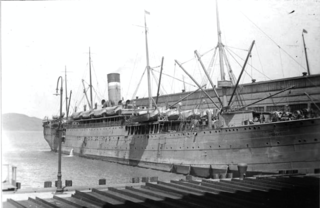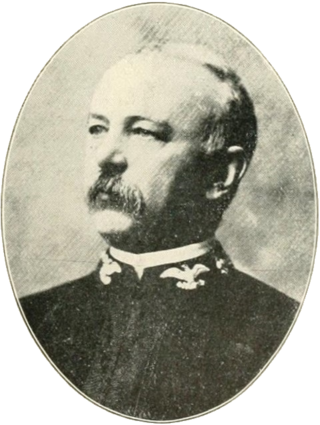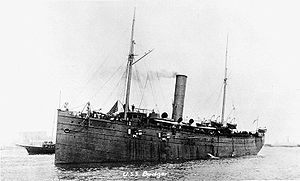
The first USS Newark (C-1) was a United States Navy protected cruiser, the eighth protected cruiser launched by the United States. In design, she succeeded the "ABC" cruisers Atlanta, Boston, and Chicago with better protection, higher speed, and a uniform 6-inch gun armament. Four additional protected cruisers were launched for the USN prior to Newark.

The second USS Buffalo was an auxiliary cruiser of the United States Navy, and later a destroyer tender.

The first USS Dixie was a United States Navy auxiliary cruiser and later a destroyer tender. The Dixie was the first ship of the United States Navy to have this name.

The Asiatic Squadron was a squadron of United States Navy warships stationed in East Asia during the latter half of the 19th century. It was created in 1868 when the East India Squadron was disbanded. Vessels of the squadron were primarily involved in matters relating to American commerce with China and Japan, though it participated in several conflicts over 34 years of service until becoming the Asiatic Fleet in 1902.

The second USS Marblehead (C-11/PG-27) was a Montgomery-class unprotected cruiser in the United States Navy, authorized in the naval appropriations bill of September 7, 1888. Marblehead served in the Spanish–American War and World War I, and was the last ship of her class in service.

The third USS Princeton was a composite gunboat in the United States Navy.

USS Prairie (AD-5), formerly Morgan Liner SS El Sol, was built in 1890 by William Cramp & Sons, Philadelphia. She was purchased by the United States Navy on 6 April 1898 from the Southern Pacific Company, and commissioned two days later at New York, Commander Charles J. Train in command.

USAT Thomas was a United States Army transport ship purchased on 26 July 1898 for Spanish–American War service. Thomas served with the Army Transport Service (ATS) until retired in 1929.

USS Topeka (PG-35) was a gunboat of the United States Navy.
USS Don Juan de Austria was a U.S. Navy gunboat. Formerly a Spanish Navy Velasco class unprotected cruiser, she was captured in 1898 during the Spanish–American War and commissioned into the U.S. Navy.

The first USS Leyden was a screw steamer that operated as a tug in the U.S. Navy from 1866 to 1903 and saw combat service in the Spanish–American War in 1898.

USS Nero (AC–17), a steel steam collier, was launched in 1894 as the steamer Whitgift by J.L. Thompson and Sons, Sunderland, England. The vessel was purchased on 30 June 1898 from McCondray and Co. at San Francisco and commissioned on 8 June 1898.

The fourth USS Scorpion was a steam yacht in commission in the United States Navy from 1898 to 1899, 1899 to 1901, and 1902 to 1927.

SS Yorktown was launched February 10, 1894, by Delaware River Iron Ship Building and Engine Works, Chester, Pennsylvania for the Old Dominion Steamship Company for the company's overnight New York City/Norfolk, Virginia service. The United States Navy purchased Yorktown on April 21, 1898, to be commissioned as the second USS Resolute, an auxiliary cruiser and transport that saw naval service during the Spanish–American War 1898–1899. The United States Department of War acquired the ship on January 22, 1900, for service as the United States Army Transport (USAT) Rawlins. The ship was sold to the Merchants and Miners Transportation Company of Baltimore, Maryland on July 27, 1901, and renamed Powhatan. Powhatan was wrecked in 1916 and in 1919 rebuilt as the world's first turbo-electric propelled passenger ship Cuba for luxury passenger and express freight service between Florida and Cuba with the Miami Steamship Company beginning service in 1920. Renamed Seneca, the ship burned and sank December 30, 1927, at Hoboken, New Jersey then refloated September 2, 1928, and scrapped.

The second USS Uncas was a United States Navy tug in commission from 1898 to 1922.

USS Fortune was a steam-powered tugboat that served in the United States Navy intermittently from 1871 to 1922. Built in 1865, she was the first ship so named. Fortune was classified as YT-11 on 17 July 1920. Through her lengthy career, she served as a harbor tug, fireboat, cargo transport, training ship, and submarine tender, among other duties.

Rear Admiral Philip Henry Cooper was an officer in the United States Navy. He fought in the American Civil War and served as Superintendent of the United States Naval Academy and as commander-in-chief of the United States Asiatic Fleet.

Rear Admiral Reginald Rowan Belknap was an officer in the United States Navy. He served in the Spanish–American War, Boxer Rebellion, Philippine–American War, and World War I. He gained distinction in 1909 for his relief work in Italy after the 1908 Messina earthquake and tsunami and for his work in command of the first offensive mining campaign in U.S. Navy history, the laying of the North Sea Mine Barrage in 1918. He was also a published author, an inventor, a member of many professional and social organizations, and an active member of the Episcopal Church, and he played a role in the selection of Amelia Earhart as the first female pilot to make a solo flight across the Atlantic Ocean.

United States Navy Auxiliary ship Sterling was an iron, schooner-rigged collier in service with the United States Navy from 1898 to 1919. Originally purchased to transport coal for United States Navy ships during the Spanish–American War, she served in that role until sold in 1919. While serving as the Chilean flagged steamer, Llai Llai, she was rammed by a Chilean warship on 11 March 1920 and sank near Iquique, Chile.

USS Wompatuck (YT-27) was an armed tug in commission in the United States Navy from 1898 to 1931. Early in her naval career, she saw combat in the Spanish–American War and the Philippine–American War. After she was decommissioned, she was selected for conversion into the fuel oil barge YO-64, but she was lost in the early days of World War II in the Pacific before the conversion could be completed.





















